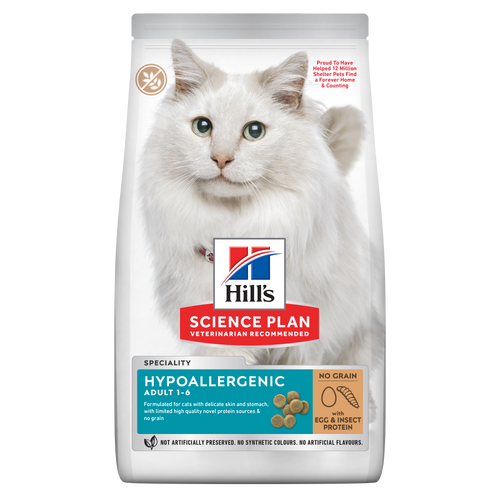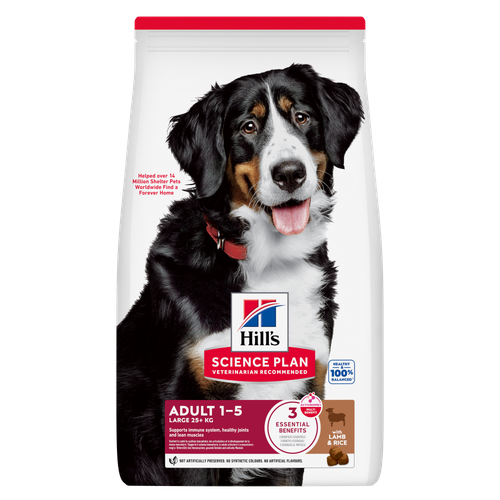
-
Find the right food for your petTake this quiz to see which food may be the best for your furry friend.Find the right food for your petTake this quiz to see which food may be the best for your furry friend.Featured products
 Perfect Digestion Large Breed Puppy Food
Perfect Digestion Large Breed Puppy FoodPrecisely balanced nutrition with Hill's ActivBiome+ prebiotic blend actively contributes to supporting digestive health and overall well-being to help your pet feel their best
Shop Now Perfect Digestion Small & Mini Adult Dog Food
Perfect Digestion Small & Mini Adult Dog FoodHill's Science Plan Perfect Digestion Small & Mini Breed Adult Dog Food with Chicken & Brown Rice supports ultimate digestive well-being & a healthy microbiome.
Shop Now Small & Mini Mature Adult 7+ Dog Food
Small & Mini Mature Adult 7+ Dog FoodHill's Science Plan Small & Mini Breed Mature Adult Dog Food with Chicken is a complete pet food, specially formulated with ActivBiome+ Multi-Benefit Technology.
Tailored nutrition to support graceful ageing in small dogs. Specially made with a synergistic blend of nutrients for energy & vigor.Shop NowFeatured products Kitten Food
Kitten FoodTender chicken chunks in gravy for kittens, with omega-3s for healthy eye & brain development and high-quality protein to support muscle growth. With balanced minerals to promote strong bones & teeth.
Shop Now Hairball & Perfect Coat Adult Cat Food
Hairball & Perfect Coat Adult Cat FoodHill's Science Plan HAIRBALL & PERFECT COAT Adult cat food with Chicken is specially formulated to effectively help avoid hairball formation in adult cats while promoting a beautiful coat. Thanks to its mix of essential Omega-6 fatty acids, this food benefits the cat's skin and fur keeping them healthy and shiny. Our Advanced Fibre Technology helps reduce hairballs by naturally promoting their passage through the gut. This food is formulated with high-quality protein for a perfectly balanced, great-tasting recipe.
Shop Now Hypoallergenic Dry Cat Food
Hypoallergenic Dry Cat FoodHILL'S SCIENCE PLAN Hypoallergenic Adult cat food with egg & insect protein is a complete pet food for adult cat 1–6 years old. It's formulated for cats with delicate skin and stomach, with limited high quality novel protein sources & no grain.
Shop Now -
Dog
- Dog Tips & Articles
-
Health Category
- Weight
- Food & Environmental Sensitivities
- Urinary
- Digestive
- Joint
- Kidney
-
Life Stage
- Puppy Nutrition
- Adult Nutrition
- Senior Nutrition
Cat- Cat Tips & Articles
-
Health Category
- Weight
- Skin & Food Sensitivities
- Urinary
- Digestive
- Kidney
-
Life Stage
- Kitten Nutrition
- Adult Nutrition
Featured articles The Right Diet For Your Pet
The Right Diet For Your PetLearn what to look for in healthy pet food & nutrition, including ingredients, quality of the manufacturer, your pet's age, and any special needs they have
Read More Understanding Your Pet's Microbiome
Understanding Your Pet's MicrobiomeLearn what a pet's microbiome is, how it contributes to your pet's gut & overall health, and why nutrition is important in maintaining healthy microbiomes.
Read More Pet Food Storage Tips
Pet Food Storage TipsWhere you store your cat and dog food can make a big difference in the quality and freshness once it is opened. Here are some common questions and recommendations for optimal storage for all of Hill’s dry and canned cat and dog food.
Read More -


Taking your dog to the veterinarian can be an ordeal under the best circumstances. If you're dealing with a dog that's scared of vet visits, checkups can be as stressful for you as they are for your pup. It can be enough to tempt you to skip the annual appointment and reserve the vet's office for emergencies. But annual wellness checks are an important part of your dog's healthcare. If your dog hates going to the vet, keep reading. Here are some tips to make vet visits go a lot more smoothly for both you and your pooch.
Socialize Your Pup
 Ideally, puppies should become socialized between seven weeks and four months of age. This is the period of development during which a dog's personality is formed, and the more a puppy sees, hears, smells and experiences during this time, the less fearful he'll be as an adult. If you're dealing with an older dog scared of vet appointments, it could be that he wasn't properly socialized during this critical time frame, or it could simply be that he acquired negative associations with going to the vet as a puppy. Either way, it's never too late to start getting your dog used to new sights, sounds and situations. Seize every opportunity to introduce him to new people, pets and experiences. If your dog becomes fearful and aggressive, you may need to use a muzzle until his fear response goes away. You can also talk to your vet to see if he or she has any methods for acclimatising your dog to the environment that has worked for other dogs in the past.
Ideally, puppies should become socialized between seven weeks and four months of age. This is the period of development during which a dog's personality is formed, and the more a puppy sees, hears, smells and experiences during this time, the less fearful he'll be as an adult. If you're dealing with an older dog scared of vet appointments, it could be that he wasn't properly socialized during this critical time frame, or it could simply be that he acquired negative associations with going to the vet as a puppy. Either way, it's never too late to start getting your dog used to new sights, sounds and situations. Seize every opportunity to introduce him to new people, pets and experiences. If your dog becomes fearful and aggressive, you may need to use a muzzle until his fear response goes away. You can also talk to your vet to see if he or she has any methods for acclimatising your dog to the environment that has worked for other dogs in the past.


Tasty Tips
Desensitize Your Dog to Touch
It's inevitable that your pooch will be held, poked and prodded when at the vet, which can be especially scary if he's not used to it. Animal Behavior College recommends spending time handling your dog and getting him used to being touched all over. Once he's relaxed, begin by gently handling his ears and paws, touching his lips and opening his mouth. Reward him with treats and plenty of praise as you go to help create positive associations with being handled.
Make Car Rides No Big Deal
 For many dogs, a stressful vet visit begins with getting into the car. This is because trips to the vet may be the only time they ever travel by car. You can help your dog be more relaxed at the vet by making car rides fun. Start with short trips around the block. Then, work up to going to fun places like the dog park or the pet store. Be sure to provide plenty of positive reinforcement along the way. Once car trips start having happy endings for your pup, he'll most likely begin looking forward to hopping in for a ride. Always make sure to follow proper car safety for your dog too, to make him comfortable and safe; this can help ease any extra anxiety he might get.
For many dogs, a stressful vet visit begins with getting into the car. This is because trips to the vet may be the only time they ever travel by car. You can help your dog be more relaxed at the vet by making car rides fun. Start with short trips around the block. Then, work up to going to fun places like the dog park or the pet store. Be sure to provide plenty of positive reinforcement along the way. Once car trips start having happy endings for your pup, he'll most likely begin looking forward to hopping in for a ride. Always make sure to follow proper car safety for your dog too, to make him comfortable and safe; this can help ease any extra anxiety he might get.
Make the Vet Fun
Just as you can change your dog's associations with car rides from bad to good, you can do the same with the vet's office by taking him there for social calls between appointments. Call ahead and give the staff a heads up before you visit, and try to go at a time that's typically not busy so the doctors and techs will have time to shower your dog with attention. The AKC adds that it's a good idea to spend a few minutes just hanging out in the waiting room, allowing your dog to watch the other pets coming and going and to get used to the sounds and smells. Be sure to reward him when he's calm and relaxed, and ignore whining or anxious behavior.
Let's face it: there are some aspects of going to the vet that will never be fun for your dog. But if you're willing to work diligently to help your pup overcome his fear, he'll feel safer and more relaxed, making vet visits a much more pleasant experience for both of you.


Jean Marie Bauhaus is a pet parent, pet blogger, and novelist from Tulsa, Oklahoma, where she usually writes under the supervision of a lapful of fur babies.
Related products

Hill's Science Plan Large Breed Adult Dog Food with Lamb & Rice is a complete pet food, specially formulated with ActivBiome+ Multi-Benefit Technology.
This food is specifically designed to fuel the energy needs of large breed dogs during the prime of their life.

Hill's Science Plan Small & Mini Breed Mature Adult Dog Food with Chicken is a complete pet food, specially formulated with ActivBiome+ Multi-Benefit Technology.
Tailored nutrition to support graceful ageing in small dogs. Specially made with a synergistic blend of nutrients for energy & vigor.

Hill's Science Plan Perfect Digestion Small & Mini Breed Adult Dog Food with Chicken & Brown Rice supports ultimate digestive well-being & a healthy microbiome.

Precisely balanced nutrition with Hill's ActivBiome+ prebiotic blend actively contributes to supporting digestive health and overall well-being to help your pet feel their best
Related articles

Dog obesity is a significant problem - learn more about helping your dog become trimmer and healthier through improved nutrition.

Discover how the field of dog science is giving us more and more insights into the inner workings of our furry best friends.

Discover the causes, signs, and treatments of kidney disease in dogs and find methods of supporting your dog's kidney health. Learn more at Hill's Pet South Africa.

Learn about snake bites on dogs, including clinical symptoms to look for, what to do if you think your dog was bitten, and treatment & prevention options.

Put your dog on a diet without them knowing
Our low calorie formula helps you control your dog's weight. It's packed with high-quality protein for building lean muscles, and made with purposeful ingredients for a flavorful, nutritious meal. Clinically proven antioxidants, Vitamin C+E, help promote a healthy immune system.
Put your dog on a diet without them knowing
Our low calorie formula helps you control your dog's weight. It's packed with high-quality protein for building lean muscles, and made with purposeful ingredients for a flavorful, nutritious meal. Clinically proven antioxidants, Vitamin C+E, help promote a healthy immune system.

